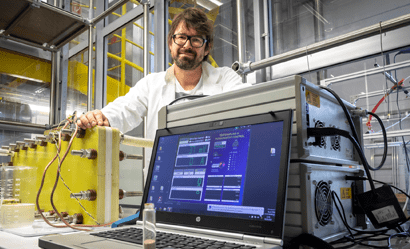“It is a groundbreaking success in the field of sustainable energy storage technologies,” says Stefan Spirk from the Institute for Bio-based Products and Paper Technology at Graz University of Technology. He and his team have succeeded in making redox flow batteries more environmentally friendly by replacing their core element – liquid electrolytes, whose components are mostly made up of ecologically harmful heavy metals or rare earths – with vanillin.
Sustainable energy storage
Vanillin – a common flavoring agent that is also contained in vanilla crescent, for example – is one of the few fine chemicals currently extracted from lignin. Spirk and his team use mild and green chemistry to convert vanillin into a redox-active material that can be used in flow batteries without the need for toxic and expensive metal catalysts. The process can be carried out at room temperature and with common household chemicals. Vanillin is also present in large quantities and can be bought in the supermarket or, by means of a simple reaction, can be separated from lignin, which in turn is produced in large quantities as waste in paper production.
The splitting and refining processes have been patented and the successful test results published in the journal “Angewandte Chemie”. Now the researchers want to commercialize the technology, especially since the process is highly scalable and suitable for continuous production. “The plan is to hook up our plant to a pulp mill and isolate the vanillin from the lignin that remains as waste. Whatever is not needed can then be returned to the regular cycle and used for energy production as usual. We are in concrete talks with Mondi, a leading global manufacturer of paper-based products, which is showing great interest in the technology,” says Spirk.
For the final implementation, he said, the technology must be tested in real operation. The company is now looking for energy supply companies that will install the start-up’s redox flow technology in its infrastructure and thus reduce the load on the grid. Spirk is convinced of success, because: “We can keep the value chain around the procurement of raw materials and components up to the generation of electricity on a regional basis, enable storage capacities of up to 800 megawatt hours, relieve the strain on the power grid and make an important contribution to the energy turnaround”.
Important piece of the puzzle for the expansion of renewable energies
Redox-flow technology is an important piece of the puzzle for the expansion of renewable energies such as wind and solar power. It is characterized by its ability to store large amounts of energy and thus cushion voltage peaks in the power grid. In addition, the batteries are suitable as backup storage for stationary applications such as power plants, hospitals, mobile phone systems or e-fuelling stations. Redox flow batteries are more easily scalable, less toxic, better recyclable and more fireproof than lithium-ion batteries. Other major advantages are their high life expectancy and low self-discharge.









